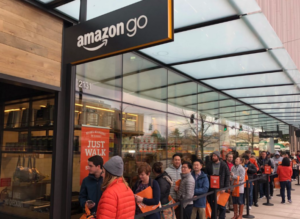- Jan 6, 2017
- 835
Get your groceries and go: Amazon debuts “Go” store with no cashiers or checkout lines.
In a move that could revolutionize the way we buy our groceries in the future, Amazon has this week opened a supermarket that has no checkout operators or tills of any sort.
After a year of trialling its new store exclusively with Amazon employees, the company has finally opened its AI powered Amazon Go store in the bottom floor of its downtown Seattle Headquarters.

Amazon GO: Now you can have 100s of cameras watch your every move while you shop, but at least you don’t have to queue.
No cash register? Sounds like a delight for shop-lifters
You would think so, but it isn’t. There are apparently cameras everywhere, however.
There are, according to Amazon, hundreds of ceiling-mounted cameras and electronic sensors to identify each customer and track the items they select.
While at the moment, shoppers have to choose from a somewhat limited selection of goods, ranging from milk, potato chips or ready-to-eat salads off its shelves. The bonus for shoppers is that they can put goods straight in their bag, and just walk out of the store.

While customers don’t have to queue to pay for their groceries, ironically they may have to spend up to a hour queuing to get in…
Amazon uses its technology to charge customers after they leave, with their purchases billed to customers’ credit cards as they leave.
Amazon have said that they use computer vision, machine learning algorithms and sensors to figure out what people are grabbing off its store shelves. When an item is pulled of a shelf, it’s added to that shopper’s virtual cart. If the item is placed back on the shelf, it is removed from the virtual cart.
Surely there must be some staff?
Of course there are. Amazon have said there will be people there making food, stocking shelves and helping customers. At about 1,800 square feet, the Amazon Go store has added to the technology giant’s growing bricks and mortar stores, and also its expansion into groceries after it purchased organic grocer Whole Foods and its 470 stores last year.
As yet the company has said it has no plans to introduce the technology to the Whole Foods chain.
In a move that could revolutionize the way we buy our groceries in the future, Amazon has this week opened a supermarket that has no checkout operators or tills of any sort.
After a year of trialling its new store exclusively with Amazon employees, the company has finally opened its AI powered Amazon Go store in the bottom floor of its downtown Seattle Headquarters.

Amazon GO: Now you can have 100s of cameras watch your every move while you shop, but at least you don’t have to queue.
No cash register? Sounds like a delight for shop-lifters
You would think so, but it isn’t. There are apparently cameras everywhere, however.
There are, according to Amazon, hundreds of ceiling-mounted cameras and electronic sensors to identify each customer and track the items they select.
While at the moment, shoppers have to choose from a somewhat limited selection of goods, ranging from milk, potato chips or ready-to-eat salads off its shelves. The bonus for shoppers is that they can put goods straight in their bag, and just walk out of the store.

While customers don’t have to queue to pay for their groceries, ironically they may have to spend up to a hour queuing to get in…
Amazon uses its technology to charge customers after they leave, with their purchases billed to customers’ credit cards as they leave.
Amazon have said that they use computer vision, machine learning algorithms and sensors to figure out what people are grabbing off its store shelves. When an item is pulled of a shelf, it’s added to that shopper’s virtual cart. If the item is placed back on the shelf, it is removed from the virtual cart.
Surely there must be some staff?
Of course there are. Amazon have said there will be people there making food, stocking shelves and helping customers. At about 1,800 square feet, the Amazon Go store has added to the technology giant’s growing bricks and mortar stores, and also its expansion into groceries after it purchased organic grocer Whole Foods and its 470 stores last year.
As yet the company has said it has no plans to introduce the technology to the Whole Foods chain.

